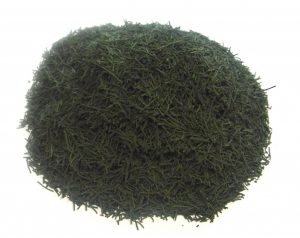
Kokeicha (固形茶) can be translated as “fixed form tea”, or “solid tea”.
The same term is used for compressed tea, such as pu-erh.
For this post, however, we’ll talk about a tea that is made into a paste and extruded so as to look similar to tea leaves.
It’s sold in and outside Japan, but it’s not as widely available as other types of Japanese teas.
History of kokeicha
The story of kokeicha goes back to 1953, when Mr. Takesawa, who worked at the tea industry in Shizuoka, had an interesting thought.
At the time, the broken pieces of tea leaves after processing, konacha, was mostly used as a fertilizer. The Japanese didn’t drink konacha as they do in the present, and teabags weren’t available either.
Mr. Takesawa thought that it was such a waste that konacha couldn’t be drunk only because the leaves didn’t have a good appearance.
With this in mind, he sought to find a way to make a better use of konacha.
He grounded the konacha into a powder, added some water to make a paste, and then dried it.
Unfortunately, when he tried brewing it, it quickly dissolved into a muddy consistency and thus it wasn’t fit for drinking. But he knew that he was on to something.
After some years of experiments, he finally found the answer. If the paste was heated to 120 °C (248 °F), the protein and the catechins of the tea would adhere and thus the paste wouldn’t disintegrate easily.
He obtained a patent for this process, and that’s how kokeicha was born.
After the Second World War, the effort was carried by Takesawa’s son, and eventually kokeicha was exported to many countries.
Presently, kokeicha doesn’t have the popularity that it once had, but nevertheless you’ll still find it in the market.
What is kokeicha made of?
It depends.
While looking online, I’ve seen kokeicha with added ingredients like rice flour and extra flavors.
The base tea can be any type of green tea, like sencha, kukicha and even matcha. Sometimes it consists of a blend of them, so it’s hard to tell for sure unless stated on the package.
In the next post, I’ll review a kokeicha. I’m eager to find out what it tastes like.
Source: 固形茶の誕生





February 28, 2019
I bought some kokeicha, now I know more about it.
Thank you.
February 28, 2019
Thanks for the comment Sebastien.
Enjoy your tea!
October 25, 2023
Always liked Kokeicha, interesting background, Thanks!